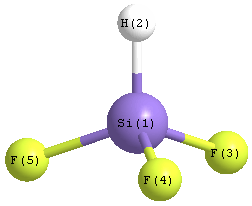All results from a given calculation for SiHF3 (trifluorosilane)
using model chemistry: CCD/daug-cc-pVTZ
19 10 17 12 22
States and conformations
| State |
Conformation |
minimum conformation |
conformer description |
state description |
| 1 |
1 |
yes |
C3V |
1A1 |
Energy calculated at CCD/daug-cc-pVTZ
| | hartrees |
|---|
| Energy at 0K | -589.076146 |
| Energy at 298.15K | |
| HF Energy | -588.184064 |
| Nuclear repulsion energy | 188.104079 |
The energy at 298.15K was derived from the energy at 0K
and an integrated heat capacity that used the calculated vibrational frequencies.
Vibrational Frequencies calculated at CCD/daug-cc-pVTZ
Geometric Data calculated at CCD/daug-cc-pVTZ
Point Group is C3v
Cartesians (Å)
| Atom |
x (Å) |
y (Å) |
z (Å) |
|---|
| Si1 |
0.000 |
0.000 |
0.325 |
| H2 |
0.000 |
0.000 |
1.781 |
| F3 |
0.000 |
1.474 |
-0.235 |
| F4 |
1.276 |
-0.737 |
-0.235 |
| F5 |
-1.276 |
-0.737 |
-0.235 |
Atom - Atom Distances (Å)
| |
Si1 |
H2 |
F3 |
F4 |
F5 |
| Si1 | | 1.4556 | 1.5762 | 1.5762 | 1.5762 |
H2 | 1.4556 | | 2.4965 | 2.4965 | 2.4965 | F3 | 1.5762 | 2.4965 | | 2.5522 | 2.5522 | F4 | 1.5762 | 2.4965 | 2.5522 | | 2.5522 | F5 | 1.5762 | 2.4965 | 2.5522 | 2.5522 | |
 More geometry information
More geometry information
Calculated Bond Angles
| atom1 |
atom2 |
atom3 |
angle |
|
atom1 |
atom2 |
atom3 |
angle |
| H2 |
Si1 |
F3 |
110.796 |
|
H2 |
Si1 |
F4 |
110.796 |
| H2 |
Si1 |
F5 |
110.796 |
|
F3 |
Si1 |
F4 |
108.115 |
| F3 |
Si1 |
F5 |
108.115 |
|
F4 |
Si1 |
F5 |
108.115 |
Electronic energy levels
Charges, Dipole, Quadrupole and Polarizability
